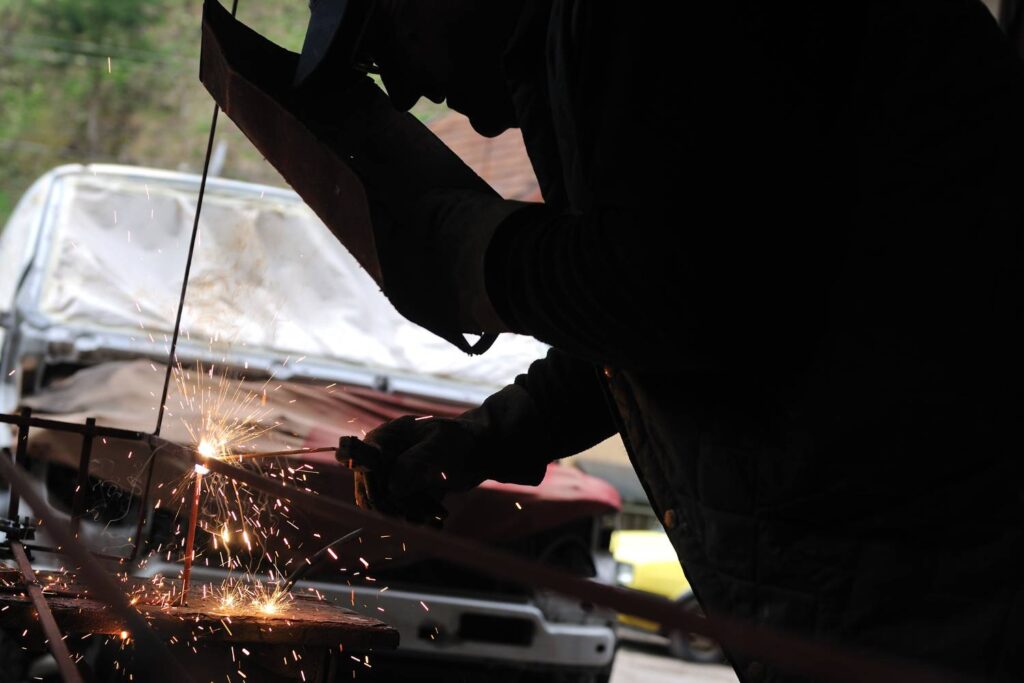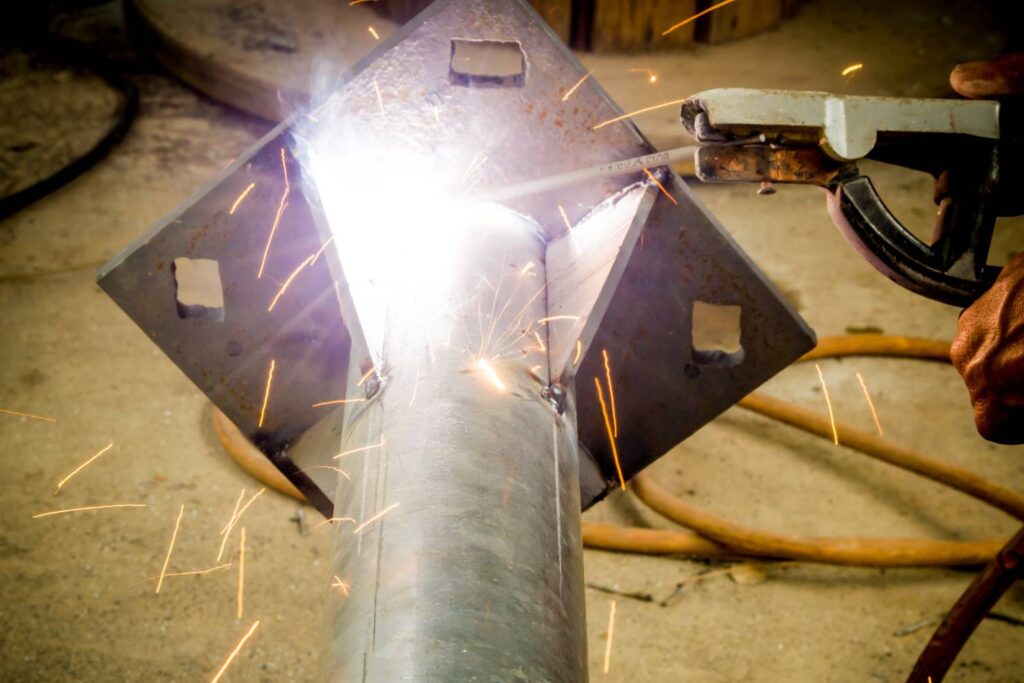This blog explores the importance of welding in metal fabrication and construction, focusing on the top priority of a welder. It explores the core values that guide welders in their craft beyond technical skills and expertise. The blog is designed for seasoned professionals and aspiring welders, offering insights beyond skill and technique, aiming to answer the pressing question of a welder's top priority.
Table of Contents
The Essence Of Welding
Welding, a process that might seem purely industrial at first glance, is pivotal in our modern world's functionality and aesthetics. The essence of welding extends far beyond its practical applications, touching upon art, safety, and innovation.
This unique content, derived from various authoritative sources, aims to illuminate the multifaceted importance of welding, underscoring why it should be a top priority in both industrial and creative sectors.

The Indispensable Role Of Welding In Industry
Welding's significance in the industrial sector cannot be overstated. It is the backbone of manufacturing, enabling the creation of everything from household appliances to vehicles and bridges to skyscrapers. The process allows for joining metals and alloys with high precision and strength and contributes to the economic construction of various products.
The evolution of welding technologies has paralleled industrial growth, highlighting its critical role in developing and maintaining infrastructure and machinery. The necessity for qualified welding engineers with a deep understanding of welding metallurgy emphasises this field's technical complexity and importance.
Quality And Integrity In Welding Inspection
The integrity of a welding inspector is paramount, ensuring that welded structures meet stringent safety and quality standards. This role demands meticulous attention to detail, a profound knowledge of welding processes, and the ability to communicate effectively.
Inspectors must navigate the challenges of maintaining neutrality, even when facing external pressures, to uphold welded constructions' structural integrity and safety. Their expertise guarantees the reliability of welding work and safeguards lives, underscoring the ethical and professional standards required in the welding industry.
Welding As An Artistic Endeavor
Welding's application extends into the realm of art, where it transforms cold metal into expressions of beauty and creativity. Artists use welding to craft sculptures, ornamental pieces, and functional art, demonstrating metalwork's versatility and expressive potential.
This artistic welding merges technical skill with imagination, producing works that captivate and inspire. The use of diverse materials, from steel to aluminium, and techniques from MIG to TIG welding, allows artists to explore a vast spectrum of textures, forms, and visual impacts, making welding a potent medium for artistic expression.
Thermit Welding: Revolutionizing Rail Maintenance
Thermit welding, a specialised process, plays a crucial role in rail infrastructure maintenance, offering a fast, efficient, and precise method for joining rail segments. This technique is celebrated for its ability to produce consistent, high-quality welds that ensure the safety and reliability of rail systems.
Its versatility in welding various metals and its operational safety make it an invaluable tool in the rail industry, where it significantly enhances the speed and effectiveness of maintenance and repair work.
Safety First: The Foundation Of Welding
Welding, a craft that melds materials into functional and artistic creations, demands respect for its inherent risks. The foundation of welding safety is built upon a comprehensive understanding of the dangers involved and the measures necessary to mitigate them. This article synthesises insights from various authoritative sources, offering a holistic view of the critical aspects of welding safety.
The 5 Golden Rules Of Welding
A foundational piece of welding safety is Adherence to essential guidelines, such as the "5 Golden Rules of Welding" outlined by Technoweld. These rules stress the importance of visibility, comfort, equipment functionality, proper technique, and foundational accuracy.
For instance, ensuring clean lenses for visibility, maintaining comfort for steadiness, verifying equipment functionality, adopting the correct welding sequence, and ensuring the foundational run is straight, and level are all crucial for safe and effective welding.
Comprehensive Safety Measures
Safety in welding extends beyond the welder to include the environment and equipment. Welding safety standards highlight the need for safety features built into welding equipment, adequate personal protective equipment (PPE), and procedures for maintaining air quality. These comprehensive measures are designed to transform welding from a potentially hazardous activity into a controlled exercise in safety.
Personal Protection And Equipment Safety
The role of personal protection must be balanced, with standards frequently addressing the need for eye and face protection, among other PPE. Equipment safety standards also play a critical role, ensuring that welding equipment's design, manufacture, installation, and use incorporate safety considerations from the outset.
Structural Codes And Non-Destructive Testing
The American Welding Society (AWS) provides structural welding codes for steel and aluminium, emphasising standardisation and safety in structural welding applications. Additionally, non-destructive weld testing standards ensure the integrity of welds without compromising the material, further underscoring the importance of safety in welding practices.
Quality Assurance: Ensuring Excellence In Welding
In the world of welding, pursuing excellence is not just about achieving the perfect bead or the most vital joint; it's about embedding quality into every phase of the welding process. Quality Assurance (QA) and Quality Control (QC) are the twin pillars supporting welding works' integrity, safety, and reliability. This article draws from a wealth of expert sources to present a comprehensive overview of ensuring excellence in welding through rigorous QA and QC processes.
The Essence Of Quality Assurance And Quality Control
Quality Assurance represents a proactive, systematic approach designed to set a series of continuous monitoring and evaluation processes, ensuring the product's quality from the get-go. It's about creating a framework that establishes systematic checks and balances to prevent deviations from the desired quality standards.
In contrast, quality control acts as the critical checkpoint in the production line, verifying that the product aligns with specified standards. It involves detailed inspections and testing of the manufacturing procedures and the final products against predefined acceptance criteria. This dual approach ensures that defects are identified promptly, allowing immediate rectification and adjustments to prevent further faulty outputs.
The Critical Role Of Welding Test Procedures
Welding test procedures are the backbone of QA and QC in welding, providing structured guidelines and protocols that ensure welding operations' consistency, reliability, and safety. Adherence to standards such as BS EN ISO 15614, BS EN ISO 9606, ASME IX, BCAR A8-A10, and BS 4872 is non-negotiable for maintaining the highest quality and safety standards in welding. These procedures cover everything from the welding procedure range and welder qualification range to specific requirements for aerospace testing and welder performance.
Implementing Qa And Qc In Welding
The implementation of QA and QC in welding involves several key steps:
- Adherence to Standards: Compliance with national and international standards is crucial. This Adherence ensures that welding services meet and exceed stringent requirements, guaranteeing the integrity and reliability of welded components.
- Welding Procedure Development: Welding procedures must be meticulously developed and tested to align with specific industry requirements, ensuring optimal weld quality.
- Welder Qualification: Welders undergo rigorous testing and training to demonstrate their competence in performing welding tasks to the highest standards, ensuring that only skilled professionals execute welding procedures.
- Comprehensive Documentation: Maintaining detailed documentation of all welding test procedures, qualifications, and process records is essential for quality assurance and traceability.
- Continuous Improvement: Quality assurance is an ongoing process. Regularly review and refine welding test procedures, incorporating lessons learned and best practices, and enhance welding operations' quality, safety, and efficiency.
Precision And Accuracy: The Mark Of A Skilled Welder
In welding, precision and accuracy are not just technical requirements; they are the hallmarks of mastery that distinguish the skilled welder. This article synthesises insights from various authoritative sources to underscore the critical importance of these attributes in welding practices.
The Foundation Of Precision Welding
Precision in welding encompasses more than the mere alignment of components; it involves the meticulous control of every aspect of the welding process. From the selection and preparation of materials to the execution of the weld itself, precision ensures the welded assembly's structural integrity, aesthetic quality, and functional reliability.
High-quality TIG welding machines, renowned for their ability to facilitate precise control over the welding process, are instrumental in achieving such exacting standards.
These machines enable welders to produce clean, high-quality welds with minimal distortion, making precision welding indispensable in industries where the margin for error is virtually nonexistent.

Challenges And Solutions In Achieving Precision
Achieving precision in welding is fraught with challenges, particularly for those new to the craft. The process demands a steady hand, a keen eye, and an intimate understanding of the materials and techniques.
One of the primary hurdles is maintaining the optimal distance and angle of the welding torch, ensuring consistent heat application and arc stability throughout the weld. This requires not only technical knowledge and skill but also a significant amount of practice and experience.
Experts recommend using calibrated tools to measure and verify the thickness of materials before welding, ensuring compatibility and uniformity. Additionally, understanding the properties of different metals and adjusting welding techniques accordingly is crucial for maintaining precision. Regular calibration of welding equipment, Adherence to Welding Procedure Specifications (WPS), and rigorous quality control measures further contribute to the accuracy of the welds.
The Role Of Experience And Continuous Learning
Mastering precision welding is ongoing, with continuous learning and skill development key. Engaging with the welding community, seeking mentorship, and staying abreast of advancements in welding technology and materials science are essential for honing one's craft.
Practical experience gained through hands-on practice and experimentation is invaluable. Welders are encouraged to practice on scrap materials, experimenting with different settings and techniques to understand their impact on weld quality and appearance.
Conclusion
This blog explores the importance of welding in metal fabrication and construction, focusing on the top priority of a welder. Welding is a multifaceted process beyond its practical applications, including art, safety, and innovation. It is the backbone of manufacturing, enabling the creation of various products such as household appliances, vehicles, bridges, and skyscrapers. The importance of welding in the industrial sector is undeniable, as it allows for joining metals and alloys with high precision and strength.
The integrity of a welding inspector is paramount, ensuring that welded structures meet stringent safety and quality standards. This requires meticulous attention to detail, profound knowledge of welding processes, and effective communication. Thermit welding, a specialised process, revolutionises rail maintenance by producing consistent, high-quality welds that ensure the safety and reliability of rail systems.
Safety is the foundation of welding safety, built upon a comprehensive understanding of the dangers and measures necessary to mitigate them. The American National Standards Institute (ANSI) emphasises the importance of safety standards that cover a broad spectrum of considerations, including equipment safety, personal protective clothing, and air quality concerns.
Personal protection and equipment safety are also critical, with standards often addressing eye and face protection and equipment safety standards.
Non-destructive weld testing standards ensure the integrity of welds without compromising the material. Quality Assurance (QA) and Quality Control (QC) are the twin pillars supporting welding works' integrity, safety, and reliability. QA is a proactive, systematic approach to establishing a continuous monitoring and evaluation framework. At the same time, Quality Control acts as the critical checkpoint in the production line, verifying that the product aligns with specified standards.
Welding test procedures are the backbone of QA and QC in welding, providing structured guidelines and protocols that ensure welding operations' consistency, reliability, and safety. Adherence to standards such as BS EN ISO 15614, BS EN ISO 9606, ASME IX, BCAR A8-A10, and BS 4872 is non-negotiable for maintaining the highest quality and safety standards in welding.
Implementing QA and QC in welding involves several key steps: compliance with national and international standards, meticulous development of welding procedures, welder qualification, comprehensive documentation, and continuous improvement. Precision and accuracy are the hallmarks of mastery in welding practices, and high-quality TIG welding machines are instrumental in achieving these standards.
Achieving precision in welding requires a steady hand, a keen eye, and an intimate understanding of materials and techniques. Experts recommend calibrating tools, understanding metal properties, and adjusting welding techniques accordingly. Continuous learning and skill development are key to mastering precision welding.
Content Summary
- Welding plays a pivotal role in metal fabrication and construction, with this blog delving into the top priority of welders.
- Beyond technical skills, welders are guided by core values explored in this blog, essential for seasoned professionals and aspiring welders.
- The multifaceted importance of welding in industrial and creative sectors is illuminated, underlining its top priority status.
- Welding isn't just industrial; it merges art, safety, and innovation, influencing functionality and aesthetics in our modern world.
- From household appliances to skyscrapers, welding is indispensable in manufacturing a diverse range of products.
- Evolution in welding technologies parallels industrial growth, highlighting its critical role in infrastructure development.
- Qualified welding engineers with deep metallurgical understanding are essential for maintaining technical complexity.
- Welding inspectors ensure welded structures meet stringent safety and quality standards, emphasising integrity.
- Upholding neutrality is crucial for inspectors, ensuring structural integrity and safety amid external pressures.
- Welding extends into art, transforming metal into expressive sculptures and functional pieces.
- Artists utilise diverse materials and techniques, making welding a potent medium for artistic expression.
- Thermit welding revolutionises rail maintenance, offering fast, efficient, and precise rail segment joining.
- Safety is paramount in welding, demanding respect for its inherent risks.
- Understanding risks like heat and fumes is vital, with safety standards ensuring protection for welders and the environment.
- Adhering to essential guidelines like the "5 Golden Rules of Welding" is foundational for safety.
- Safety measures extend to equipment, with standards ensuring design and operation incorporate safety considerations.
- Structural codes and non-destructive testing further ensure the integrity of welds without material compromise.
- Quality Assurance (QA) and Quality Control (QC) are essential for embedding excellence in welding.
- QA ensures continuous monitoring and evaluation for quality maintenance, establishing systematic processes.
- QC verifies that products align with specified standards, promptly identifying defects for rectification.
- Welding test procedures provide structured guidelines for consistency, reliability, and safety in operations.
- Adherence to standards, development of welding procedures, and welder qualification are critical steps in implementation.
- Comprehensive documentation and continuous improvement enhance quality assurance in welding.
- Precision and accuracy are crucial in welding, distinguishing skilled welders.
- Precision encompasses meticulous control of every aspect of the welding process for reliability and quality.
- TIG welding machines facilitate precise control, producing clean welds with minimal distortion.
- Challenges in achieving precision include maintaining the optimal distance and angle of the welding torch.
- Calibrated tools and understanding metal properties are essential for maintaining precision.
- Experience, continuous learning, and practical experimentation are vital for mastering precision welding.
Frequently Asked Questions
The primary focus of a welder is to ensure the integrity, safety, and quality of the welds they produce.
Understanding the top priority of a welder is crucial for ensuring that welding tasks are approached with the appropriate emphasis on safety, quality, and professionalism.
The top priority of a welder is beyond technical proficiency. It includes Adherence to safety protocols and maintaining integrity in welds and often involves artistic expression in specific contexts.
Welding is essential in industries ranging from construction and manufacturing to art and sculpture. It plays a critical role in creating everything from infrastructure to decorative pieces.
Core values guiding welders include precision, safety, integrity, attention to detail, and craftsmanship.

